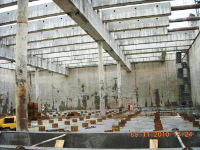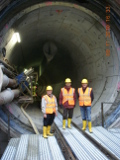 |
 |
|||||||||||||
|
|||||||||||||
|
|||||||||||||
|
Early November, four members of the Global Design Effort Conventional Facilities and Siting group and two guests from Japanese industry visited DESY in Hamburg, Germany, for two days. They wanted to find out more about the current state of the European X-ray Free Electron Laser (XFEL) civil construction and to get information about other relevant projects like DESY’s FLASH accelerator. On the agenda for the first day of the visit were the XFEL injector building (currently not much more than a huge hole in the ground), a mock-up tunnel where people practice transport and installation of modules under almost real conditions, the HERA Hall West, home to a lab for future detectors, and the HERA accelerator tunnel. The next day, a Tuesday and regular maintenance day, they inspected the FLASH linac tunnel. The afternoon featured the highlight of the tour: the construction area for the research buildings of the European XFEL in the small town of Schenefeld. The excavation of the experimental hall pit, made with slurry walls and an underwater concrete slab, is already finished. The whole volume sits in the water table. Therefore the basement is fixed by several hundred friction anchors in the ground and the walls are stabilised by a grid of concrete beams. The group was able to go downstairs to the slab and get an impression of the size of the hall — it will be 90 metres long, 50 metres wide and will house several experiment stations. Final construction is on the way and the visitors were able to watch the process of preparing the tunnel boring for the photon beam lines leading to the experimental hall. The construction of the second linac tunnel started at this construction area just a couple of weeks ago. The inner diameter is 5.3 metres. The tunnel is bored by a tunnel-boring machine (TBM) and lined with precast watertight concrete segments. The TBM cutting head rotates in a compartment filled with a pressured liquid called bentonite. The bentonite suspension resists the soil and hydraulic pressure to avoid displacements at the surface. The liquid also transports the soil, which will be separated above ground in centrifuges. Within the steel cylinder behind the head (called the shield) a complete tunnel ring is assembled from the precast concrete segments. The three regional leaders from the civil facilities and siting (CFS) group had a chance to visit the TBM (called TULA, or "Tunnel for Laser") in excavation mode, and were able to inspect the control cabin of the machine and observe the installation of one complete ring. They were very impressed by the precision of the tunnel-boring machine in soft ground, observing only a three-millimetre deviation from its theoretical position! The team also saw how one can construct shallow tunnels and underground buildings in water-saturated soil, what the design of a single accelerator tunnel could look like and how the installation of the components could be handled. The two-day visit proved very fruitful, and the CFS team's many ideas and lessons learnt were taken on board with them. -- Wilhelm Bialowons (DESY)
- More about the European XFEL |
|||||||||||||
| © International Linear Collider |

